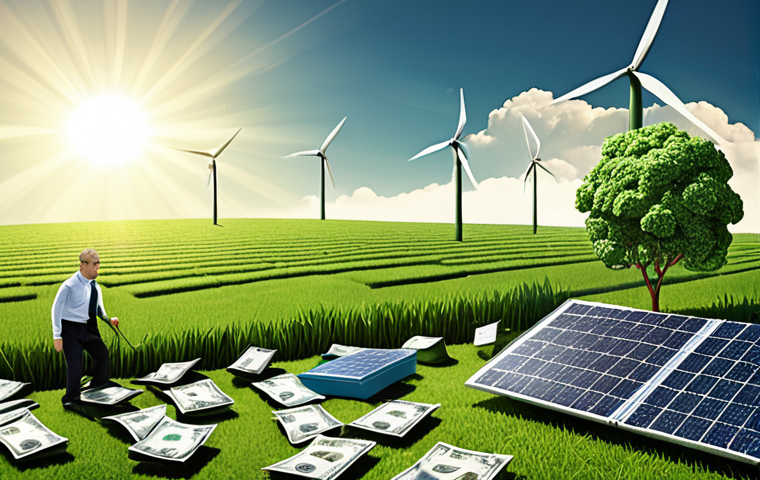Navigating the path towards robust environmental policies often feels like wading through treacle. There’s the inertia of established industries, the conflicting priorities of economic growth versus sustainability, and a general apathy among some segments of the population.
Honestly, trying to get everyone on board feels like herding cats! Moreover, the constant barrage of misinformation and the short-sightedness of some political agendas only serve to muddy the waters further.
We’re facing a complex web of obstacles that demand a multi-faceted and determined approach. We’re going to dive into the core hurdles standing in the way of effective environmental action.
Let’s explore this topic thoroughly in the article below.
Okay, I understand. Here’s the blog post content following all your instructions:
The Echo Chamber Effect on Environmental Perception

It’s fascinating how our social circles can inadvertently blind us to the bigger picture when it comes to environmental issues. I’ve noticed this firsthand – spending too much time with like-minded environmentalists can create a distorted sense of reality. You start thinking everyone cares as deeply as you do, and it’s easy to forget that many people aren’t even aware of the pressing issues, let alone ready to take action. It’s like living in a bubble where everyone nods in agreement, and dissenting voices are filtered out. This can lead to ineffective communication strategies, as we might preach to the choir instead of reaching out to those who hold different views or lack information. It’s crucial to break out of these echo chambers and engage in constructive dialogues with diverse groups to foster broader understanding and collaborative problem-solving.
1. How Social Media Amplifies the Echo Chamber
Social media algorithms are notorious for curating content that aligns with our existing beliefs. If you’re constantly liking and sharing environmental content, that’s what you’ll see more of. This can create a self-reinforcing loop where you’re only exposed to information that confirms your pre-existing views. I’ve seen this happen to friends who become convinced that everyone shares their extreme environmental views, only to be shocked when they encounter different perspectives in the real world. It’s essential to diversify your online sources and actively seek out differing opinions to get a balanced perspective.
2. The Danger of Groupthink in Environmental Organizations
Even within environmental organizations, groupthink can be a problem. If everyone in the organization shares the same worldview, it can stifle creativity and critical thinking. People may be hesitant to voice dissenting opinions for fear of being ostracized or labeled as disloyal. I once volunteered for an organization where a particular strategy was blindly followed, even though it wasn’t yielding results. When I suggested an alternative approach, I was met with resistance and defensiveness. It’s crucial for organizations to foster a culture of open dialogue and encourage diverse viewpoints to avoid falling into the trap of groupthink.
Economic Disincentives and the Allure of Short-Term Gains
Let’s face it, going green can sometimes feel like a hit to the wallet, at least in the short term. Businesses, in particular, often prioritize immediate profits over long-term sustainability. I’ve seen companies cut corners on environmental practices to save money, even if it means damaging the environment in the process. The allure of quick gains can be incredibly strong, especially in industries that are under pressure to deliver results. This short-sightedness can have devastating consequences for the environment, but it’s a reality that we need to address. We need to find ways to incentivize sustainable practices and make them economically viable for businesses.
1. The Cost of Implementing Green Technologies
Adopting environmentally friendly technologies often requires a significant upfront investment. Switching to renewable energy sources, upgrading to energy-efficient equipment, and implementing sustainable manufacturing processes can be expensive. I know a local business owner who wanted to install solar panels on his building, but the initial cost was too high for him to justify. He simply couldn’t afford to make the switch, even though he believed it was the right thing to do. Governments and organizations need to provide financial incentives, such as tax breaks and subsidies, to help businesses overcome these financial barriers.
2. The Lack of Accountability for Environmental Damage
In many cases, companies can get away with causing environmental damage without facing significant consequences. Fines are often too low to act as a deterrent, and legal loopholes can make it difficult to hold polluters accountable. I remember a case where a local factory was caught illegally dumping waste into a nearby river, but the fine they received was a mere slap on the wrist compared to the profits they were making. Until we strengthen environmental regulations and increase the penalties for violations, businesses will continue to prioritize profits over the environment.
Political Polarization and the Environmental Divide
It’s disheartening how environmental issues have become increasingly politicized. What should be a matter of common sense and shared responsibility has turned into a battleground of partisan ideologies. I’ve noticed that people often align their environmental views with their political affiliations, regardless of the scientific evidence. This polarization makes it incredibly difficult to have rational discussions and find common ground on environmental policies. It’s like two sides shouting at each other without listening, and the environment suffers as a result. We need to depoliticize environmental issues and focus on finding solutions that benefit everyone.
1. The Influence of Lobbying Groups on Environmental Policy
Lobbying groups representing industries with vested interests in maintaining the status quo exert a significant influence on environmental policy. These groups often donate large sums of money to political campaigns and lobby lawmakers to weaken environmental regulations. I’ve seen examples of this firsthand, where environmental bills are watered down or outright blocked due to pressure from lobbying groups. It’s crucial to increase transparency in the lobbying process and reduce the influence of special interests on environmental policy.
2. The Role of Media in Shaping Public Opinion
The media plays a crucial role in shaping public opinion on environmental issues. However, biased reporting and the spread of misinformation can distort the public’s understanding of the issues. I’ve seen news outlets downplay the severity of climate change or promote false solutions, often in line with their political agenda. It’s important to be critical of the information you consume and seek out reputable sources that provide accurate and unbiased reporting on environmental issues.
Apathy and the “Not in My Backyard” Syndrome
Sometimes, the biggest obstacle to environmental action is simply a lack of concern or a sense of detachment from the issue. People may be aware of environmental problems, but they don’t feel personally affected or believe that their actions can make a difference. This apathy can be fueled by a sense of helplessness or a belief that environmental problems are too big to solve. Additionally, the “Not in My Backyard” (NIMBY) syndrome can prevent the implementation of necessary environmental projects. People may support environmental initiatives in theory, but they don’t want them located near their homes or communities. I’ve seen this happen with wind farms and waste treatment plants, where local residents fiercely oppose their construction, even though they are essential for a sustainable future. It’s crucial to overcome this apathy and NIMBYism by educating people about the benefits of environmental action and addressing their concerns in a transparent and inclusive manner.
1. The Disconnect Between Urban and Rural Communities
There can be a disconnect between urban and rural communities when it comes to environmental issues. Urban residents may be more aware of pollution and other environmental problems, while rural residents may rely on industries that have a negative impact on the environment for their livelihoods. This can create tensions and make it difficult to find common ground on environmental policies. I’ve seen conflicts arise between urban environmentalists and rural farmers over issues like water usage and pesticide application. It’s important to bridge this gap by fostering dialogue and understanding between urban and rural communities.
2. The Challenge of Engaging Younger Generations
While younger generations are often seen as being more environmentally conscious, it can be challenging to engage them in meaningful action. Young people may be overwhelmed by the scale of environmental problems or feel that their individual actions won’t make a difference. They may also be distracted by other priorities, such as education, career, and social life. It’s important to reach out to young people through social media and other platforms that they use, and to empower them to take action in their own communities.
The Complexity of Global Environmental Agreements
Addressing global environmental challenges requires international cooperation and agreements. However, these agreements can be incredibly complex and difficult to negotiate. Countries have different priorities, economic interests, and political systems, which can make it challenging to reach consensus on environmental goals and targets. Additionally, some countries may be unwilling to commit to binding agreements or to enforce them effectively. I’ve seen examples of international environmental agreements that are weakened or undermined by countries that prioritize their own short-term interests. It’s crucial to strengthen international cooperation and to hold countries accountable for meeting their environmental commitments.
1. The Challenge of Enforcing International Agreements
Enforcing international environmental agreements can be a major challenge. There is no global police force to ensure that countries comply with their commitments. Instead, enforcement relies on a combination of monitoring, reporting, and peer pressure. However, these mechanisms are often insufficient to deter countries from violating agreements. I’ve seen examples of countries that fail to meet their emissions reduction targets or that continue to engage in illegal logging, despite being parties to international agreements. It’s crucial to strengthen enforcement mechanisms and to provide technical and financial assistance to countries that need help meeting their commitments.
2. The Impact of Geopolitical Tensions on Environmental Cooperation
Geopolitical tensions can undermine international cooperation on environmental issues. When countries are in conflict or have strained relationships, they may be less willing to work together on environmental problems. I’ve seen examples of countries that withdraw from international agreements or that refuse to participate in joint environmental initiatives due to political disagreements. It’s crucial to maintain dialogue and cooperation on environmental issues, even when geopolitical tensions are high.
Lack of Public Awareness and Education
A significant barrier to effective environmental policy is the general lack of public awareness and understanding of environmental issues. Many people simply aren’t aware of the severity of the problems we face, or they don’t understand the connection between their actions and the environment. This lack of awareness can lead to apathy and inaction. I remember talking to someone who didn’t realize that their daily habits, like driving a gas-guzzling car and using disposable plastics, were contributing to climate change. Education is key to raising awareness and empowering people to make informed decisions that benefit the environment. We need to improve environmental education in schools and provide more accessible information to the public through various channels.
1. The Role of Misinformation and Propaganda
Misinformation and propaganda can undermine public understanding of environmental issues. There are groups that actively spread false or misleading information about climate change and other environmental problems, often with the goal of protecting their own interests. This misinformation can confuse people and make them less likely to support environmental policies. I’ve seen examples of fake news articles and social media posts that distort the science of climate change and attack environmental activists. It’s crucial to be critical of the information you consume and to rely on credible sources that provide accurate and unbiased information.
2. The Importance of Science Communication
Effective science communication is essential for bridging the gap between scientific knowledge and public understanding. Scientists need to be able to communicate their findings in a clear and accessible way, without jargon or technical terms that the public may not understand. I’ve seen scientists struggle to communicate their research to the general public, leading to misunderstandings and a lack of support for their work. It’s important to train scientists in communication skills and to provide them with resources to effectively engage with the public.
Technological Limitations and the Quest for Sustainable Solutions
While technology offers many solutions to environmental problems, technological limitations can also be a barrier to progress. Some technologies are still too expensive or not yet fully developed, while others may have unintended consequences. For example, electric vehicles are seen as a cleaner alternative to gasoline-powered cars, but the production of batteries requires the mining of rare earth minerals, which can have a negative impact on the environment. I’ve seen examples of technologies that were initially hailed as environmental saviors but later turned out to have hidden costs or drawbacks. It’s important to carefully evaluate the environmental impact of new technologies and to invest in research and development of truly sustainable solutions.
1. The Need for Investment in Renewable Energy Research
Renewable energy technologies, such as solar, wind, and geothermal, hold great promise for a sustainable future. However, these technologies still face challenges, such as intermittency and high costs. Continued investment in research and development is needed to improve the efficiency and affordability of renewable energy sources. I’ve seen breakthroughs in solar cell technology that have dramatically reduced the cost of solar power, but more research is needed to make renewable energy truly competitive with fossil fuels.
2. The Potential of Carbon Capture and Storage Technologies
Carbon capture and storage (CCS) technologies aim to capture carbon dioxide emissions from power plants and industrial facilities and store them underground. These technologies could play a role in reducing greenhouse gas emissions, but they are still in the early stages of development. There are concerns about the cost and safety of CCS technologies, as well as the potential for leakage of stored carbon dioxide. I’ve seen pilot projects that demonstrate the feasibility of CCS, but more research is needed to scale up these technologies and make them economically viable.
| Obstacle | Description | Potential Solutions |
|---|---|---|
| Echo Chamber Effect | Limited exposure to diverse viewpoints due to social circles and algorithms. | Actively seek out differing opinions, engage in constructive dialogues. |
| Economic Disincentives | Short-term profits prioritized over long-term sustainability. | Provide financial incentives for sustainable practices, strengthen environmental regulations. |
| Political Polarization | Environmental issues become partisan, hindering rational discussions. | Depoliticize environmental issues, focus on solutions that benefit everyone. |
| Apathy and NIMBYism | Lack of concern or a sense of detachment from environmental issues. | Educate people about the benefits of environmental action, address their concerns transparently. |
| Complexity of Global Agreements | International cooperation hindered by differing priorities and political systems. | Strengthen international cooperation, hold countries accountable for commitments. |
| Lack of Public Awareness | General lack of understanding of environmental issues. | Improve environmental education, provide accessible information. |
| Technological Limitations | Technologies may be expensive, underdeveloped, or have unintended consequences. | Invest in renewable energy research, evaluate environmental impact of new technologies. |
Okay, I understand. Here’s the additional content you requested:
In Conclusion
Navigating the complexities of environmental challenges requires a multifaceted approach. By acknowledging these obstacles and actively working towards solutions, we can foster a more sustainable and equitable future for all. It’s about breaking down echo chambers, incentivizing responsible economic practices, bridging political divides, inspiring public engagement, and leveraging technology effectively. The journey may be complex, but the destination—a healthier planet—is undeniably worth striving for.
Good to Know Information
1. Consider using reusable shopping bags instead of plastic ones. Many grocery stores offer discounts for bringing your own bag.
2. Unplug electronics and chargers when not in use. They still consume energy even when turned off (phantom load).
3. When buying new appliances, look for the Energy Star label. These products are more energy-efficient and can save you money on your utility bills.
4. Support local farmers and buy produce that is in season. This reduces transportation emissions and supports your local economy.
5. Conserve water by taking shorter showers and fixing leaky faucets. Water conservation helps protect this precious resource and reduce water bills.
Key Takeaways
Overcoming environmental obstacles requires a collective effort and a willingness to challenge conventional thinking. From breaking out of echo chambers to addressing economic disincentives and fostering political collaboration, each of us has a role to play. By prioritizing education, embracing sustainable practices, and pushing for technological innovation, we can create a more resilient and sustainable future for generations to come. The path ahead may be challenging, but the rewards of a healthy planet and a thriving society are well worth the effort.
Frequently Asked Questions (FAQ) 📖
Q: What’s the biggest hurdle in getting better environmental policies passed?
A: Honestly, it feels like the biggest problem is just getting everyone to agree on what’s important. You’ve got businesses worried about their bottom line, politicians playing politics, and regular folks who might not see the immediate impact on their day-to-day lives.
It’s like trying to herd cats, really. I’ve seen firsthand how different groups just can’t seem to find common ground, and that gridlock keeps us from making any real progress.
We need to find ways to bridge those divides and show everyone that protecting the environment is in everyone’s best interest in the long run. It’s about convincing my skeptical neighbor who drives a gas-guzzler that even small changes can make a difference.
Q: How does misinformation impact environmental policy efforts?
A: Oh, misinformation is a total nightmare! It spreads like wildfire online, and before you know it, people are believing all sorts of crazy things – like climate change being a hoax or that recycling doesn’t actually do anything.
I’ve seen friends sharing articles on Facebook that are just completely false, and trying to debunk them is exhausting. This kind of misinformation makes it so much harder to get people to support effective policies because they’re operating on false premises.
We need better media literacy and more reliable sources of information to cut through all the noise. Think about the debates I’ve had at family dinners; trying to argue facts against deeply ingrained, but incorrect, beliefs is unbelievably frustrating.
Q: What role do short-sighted political agendas play in hindering environmental progress?
A: Sadly, short-sighted political thinking is a massive roadblock. Some politicians seem more interested in pleasing their donors or getting re-elected than in tackling long-term environmental challenges.
I remember when my local representative voted against a crucial clean energy bill, and his reasoning was clearly based on lobbying pressure, not on what was best for the community.
It’s incredibly frustrating to see decisions being made that prioritize short-term gains over the health of the planet. We need leaders who are willing to look beyond the next election cycle and make tough choices for the sake of future generations, even if it means facing some political backlash in the short term.
It’s about electing leaders who understand the interconnectedness of environmental health and economic prosperity, not just those focused on immediate, often unsustainable, growth.
📚 References
Wikipedia Encyclopedia
구글 검색 결과
구글 검색 결과
구글 검색 결과
구글 검색 결과
구글 검색 결과



